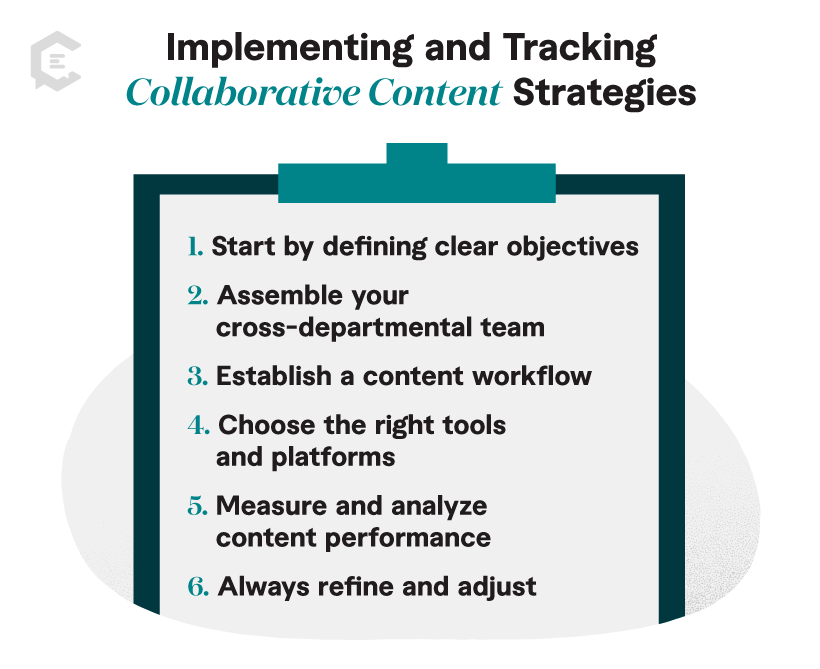You’ve probably heard the age-old saying, ‘If you want to go fast, go alone. If you want to go far, go together,’ more times than you can count. This wisdom holds especially true for us marketers, whose responsibility is to drive growth and attract new customers. Fortunately, the journey toward these goals doesn’t have to be a solo adventure.
Enter the magic of collaborative content.
Collaborative content is all about breaking down silos and sparking a culture where communication and cooperation aren’t just encouraged — they’re the norm. Pretty nice, huh? But, the real value of collaboration hinges on the tangible results it produces, so having a firm grasp on tracking and monitoring your achievements is crucial.
Below, we’ll explore the significance of monitoring metrics in your collaborative content, identify the key metrics and KPIs to keep an eye on, and outline a strategic approach to enhance the efficacy of your tracking efforts.
Additionally, as a bonus, we’ll offer an insider look at how we manage our collaborative content at ClearVoice, setting you up to effectively measure the high-quality collaborative content you’re producing (or planning to).
![]()
The Importance of Tracking Your Collaborative Content
Hopefully, we don’t have to emphasize how important data is to your marketing success. But just in case:

- 64 percent of marketing executives believe data-driven marketing is crucial to success in a hyper-competitive global economy
- 77 percent of consumers are more likely to choose a brand that offers personalized experiences based on data
- 53 percent of organizations consider data-driven marketing an integral part of their marketing approach
[Zipdo]
At ClearVoice, we incorporate data into everything we do. But we always make sure to prioritize it when we’re executing cross-departmental collaborations.
Data is a universal language that gets and keeps everyone on the same page. It guides where the ship is going, leading to:
- Enhanced team alignment: Tracking metrics improves team cohesion and drives your overall business objectives by keeping everyone focused on your content’s main goal.
- Increased content ROI: Metrics will identify which of your collaborative content efforts yield the best results, allowing for a smarter allocation of resources.
- Better audience engagement: Metrics will tell you what’s resonating most with your audience so you can refine your content creation to build off that momentum.
- Informed decision-making: Data provides specific insights into the overall performance of your collaborative content, which can guide future strategic decisions based on what’s been effective.
- Competitive advantage: Accurately measuring and optimizing your collaborative content will help you offer unique value to your audience and set yourself apart in your industry.
Most of all, metrics provide a guiding light when you’re uncertain about what’s working and what’s not. They point you where to go, ultimately leading to more effective strategies, stronger team dynamics, and greater success in your marketing efforts.
Key Metrics and KPIs to Identify in Your Collaborative Content
In your quest to quantity your collaborative content success, here are the metrics we’ve found to matter the most:

Leads “lead” the way
We will cover a range of metrics to track, but let’s be honest: we’re all focused on one thing — driving qualified leads.
Sixty-eight percent of B2B businesses struggle with lead generation. And that’s where content marketing can come to the rescue. One of the most valuable aspects of content marketing is its ability to generate leads that are genuinely interested in your products or services.

Just don’t fall into the “quantity over quality” trap. Not all leads are created equal.
Marketing qualified leads (MQLs)
An MQL is someone engaged with a brand but isn’t ready to buy yet. Maybe they’ve signed up for your email list, joined your webinar, or downloaded your eBook. They’re at the top or middle of the funnel in their buyer’s journey and want to learn more.
Tracking MQLs is important because the volume and quality of your MQLs reflect the initial engagement and interest your collaborative content is sparking. Assessing the quality of your MQLs will help you refine your collaborative content to better align with your prospective customers’ needs.
More importantly, if properly nurtured, an MQL can become a sales-qualified lead.
Sales qualified leads (SQLs)
An SQL is someone who has a higher potential to close and convert. They’re bottom-of-funnel, have indicated a high interest in your product or service, and are looking to talk to a sales team member.
The number of SQLs you generate is a direct testament to the effectiveness of your collaborative content. It tells you if your content addresses your audience’s specific pain points and needs and nurtures them effectively through the sales funnel.
That’s why, at ClearVoice, we’ve unified our sales and marketing efforts around revenue, using SQLs as our target metric of success.

Engagement = expansion
You don’t want to stop at just tracking leads. Tracking metrics around engagement and reach is also critical for assessing the success of your collaborative content. They not only measure the immediate impact of your content in terms of audience interaction but also indicate the potential for lead generation down the road.
Tracking these KPIs will help you refine your collaborative content approach over time:
Engagement metrics
Tracking engagement metrics will tell you if your content resonates with your target audience and prompt them to interact with your brand. Here are the top metrics we track:
- Time on page
- Bounce rate
- Click-through-rate (CTR)
- Conversion rate
- Pages per session
- Social shares and likes
Reach metrics
Reach metrics help you understand how often users need to see your content before taking action on them. Incorporate these into your collaborative content tracking if you haven’t already:
- Impressions
- Page views
- Video views
- Unique visitors
- Followers/subscribers
For a bonus deep dive, check out this Content Marketing Institute (CMI) piece on the top 17 metrics for measuring content marketing success.
Bottom line, all these metrics will inform how you can refine and improve your collaborative content approach. You’ll be able to leverage the data to craft content that resonates with your customers more deeply, expands your audience, and amplifies your brand’s impact.

Implementing and Tracking Collaborative Content Strategies
If you want to fully unlock the potential impact metrics can have, you have to build a robust framework to follow. Here’s a step-by-step guide:
- Start by defining clear objectives: Set clear, actionable objectives for your collaborative content. Make sure they align with overall marketing goals. The clearer the objectives, the more precise your team will be on the direction to go and the benchmark against which to measure success.
- Assemble your cross-departmental team: Collaborative content thrives on diversity. Look at departments like marketing, sales, product development, and customer service to pick your team members. It’ll give you a variety of perspectives and expertise in your content creation and ultimately make it more comprehensive and engaging.
- Establish a content workflow: We’ve already emphasized the need for clarity of vision. But you also need to have clear-cut operations. Craft a well-defined workflow where everyone knows their roles and responsibilities. Create a content calendar and establish processes and timelines around ideation, creation, review, and approval to keep everyone on track. Project management tools can be a godsend here, ensuring a seamless collaboration.
- Choose the right tools and platforms: The right project management tools can make or break your content. Leverage platforms and tools that facilitate easy communication and collaboration. That could mean anything from implementing a content management system (CMS) to using cloud-based editing tools or project management software. The goal is to make collaboration as seamless as possible (that goes double if people are working remotely or hybrid).
- Measure and analyze content performance: While choosing collaboration tools, don’t forget to pick or add ones that will help you track the performance of your collaborative content. A wide range of tech out there makes monitoring metrics extremely easy. Look at comprehensive platforms like HubSpot, Google Analytics, Salesforce, and Zoho. If you need more niche tools, check out our guide to analytics in content operations.
- Always refine and adjust: Encourage a culture of continuous feedback and learning within your team. Have regular meetings to look at the data and discuss what’s working and what isn’t. And be open to adjusting your goals and strategy based on your data’s insights and the team’s input. It’ll keep your collaborative content dynamic and continually effective.
Introducing a new framework like this can take time and effort. But once it’s up and running, you’ll have created a well-oiled machine that drives long-lasting collaborative content success.
Building Your Collaborative Content Approach
At ClearVoice, we know it takes a village to create high-quality content that achieves your goals. That’s why we emphasize a collaborative content approach for ourselves. So, if you want to use an effective collaborative content approach that drives your marketing success and overall business goals, we’ve got your back.
Talk to one of our content specialists today to get started.



